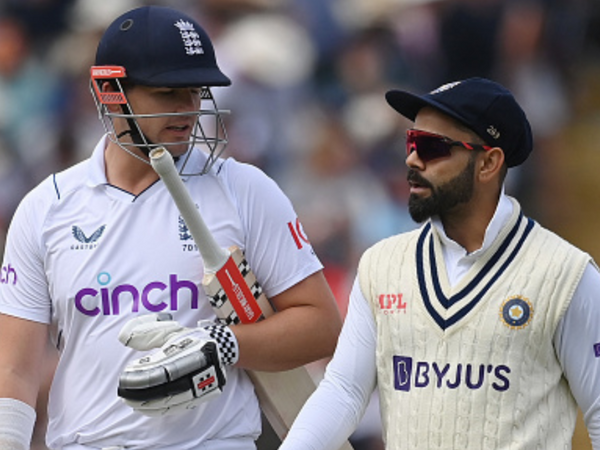
India returned to England in 2022 to complete the unfinished Test series from 2021. England’s bright, gallant batting helped them win the Edgbaston Test match and level the series 2-2. Andy Bull’s match report originally appeared in the 2023 edition of the Wisden Cricket Almanack.
Fifth Test at Birmingham, July 1-5, 2022: England won by seven wickets
England: 12pts, India: –2pts (after 2pt penalty). Toss: England
If you have ever read GK Chesterton’s parable about the man who pulls down a fence because he can’t see why it should be there, and is promptly gored to death by the bull hiding on the other side, you will have an idea how this match felt after three days. Brendon McCullum and Ben Stokes had spent their first weeks in charge of the England Test team tearing down an approach built up over 145 years, and England had won three matches against New Zealand while they were doing it. But India were a different proposition. And when they set England 378, it felt as though the Test would become a lesson in why the fences had been erected in the first place.
England, having chosen to bowl, conceded 416, then batted so rashly they conceded a deficit of 132. They ended up needing to make more than they had ever made in the fourth innings to win. History was clearing its throat, about to say: “I told you so – you can’t win Test matches batting like that, not against this kind of attack, and you won’t get away with that sort of bowling, not to those fields, anyway.”
A day later, history was still waiting. England did not just knock off their target, they raced to it – in 76.4 overs, with seven wickets to spare, breaking the national record (359), against Australia at Headingley three summers earlier. The bull had poked its nose round the corner, and Stokes’s England sent it packing.
Thanks in large part to a pair of brilliant innings by Root and Bairstow, who batted with real authority in an unbroken 269-run partnership, a potentially tense fifth day gave way to a giddy celebration of England’s new attitude. They turned Test cricket on its head. For years, it has been a tenet of the game that the best way to control a Test is by batting first and building a big total. Here, for the fourth match in succession, England flipped that around, and backed themselves to make whatever they needed batting last. Stokes’s players were only half-joking when they said he had chosen to “chase” at the toss.
India knew what to expect, and assumed they would be equal to it, even though most of the team had played only a single tour game to readjust to first-class cricket after the IPL. They had pulled out of this Fifth Test the previous year because they were worried about an outbreak of Covid among the support staff, even though no player had tested positive. Now, their new captain, Rohit Sharma, did precisely that in the run-up to this match, and spent it in isolation. Bumrah took over. He hadn’t done the job before, and his inexperience showed.
On the first day, the game had ebbed and flowed with the weather. There were clouds in the morning and, if Broad’s bowling was a little below its best, Anderson’s was characteristically exquisite. He winkled out the openers, before Potts dismissed Vihari and Kohli in seven deliveries. Then, after a two-hour rain break that allowed him to bowl long into the afternoon, Anderson removed Iyer with a short ball, to leave India 98-5. It would prove the first turning point in a twisty match – and the last time England were ahead until late on the fourth day.
Some of the reasons for the first change of direction were subtle, such as the way the ball started to go soft and the clouds to break up; others, such as Pant’s counter-attack, less so. He scored in volleys of fours and sixes, and was especially severe on Potts and Leach, who between them conceded 176 from 29 overs. Pant’s hundred – his fifth in Tests, and third against England – came off 89 balls, and he pressed on again, taking 20 off four deliveries from Leach. Jadeja was in his slipstream, and the partnership had reached 222 in less than 39 overs – India’s joint-highest abroad for the sixth wicket – when Pant edged Root to slip.
Stokes said later he had “absolutely loved” Pant’s innings. But there were questions about whether England could have done more to prevent it. It wasn’t just that they dropped five catches. It was the way Stokes persisted with attacking fields, and his bowlers refused to retreat into defensive lines and lengths. Criticism grew louder next morning: Jadeja was dropped a second time and moved to his century, while Bumrah played a startling cameo.
It had been England’s plan all summer to bowl short at the tail. They ought to have been forewarned: when they had tried the tactic in the Second Test at Lord’s the previous year, Bumrah had made a career-best 34 not out. Here, he ended up hitting Broad for 29 in an over that cost 35 – comfortably the most expensive in Test history. Bumrah, who had begun the innings with a Test average of six, ended it top of a list that had been jointly led by Brian Lara and George Bailey.
The over started with four off the top edge, continued with a bouncer that flew for five wides, and a no-ball top-edged for six. Then came a full toss, which Bumrah hit down the ground for four, a length ball that went off the inside edge to the fine-leg boundary, a pull for four which finished with Bumrah falling over, and another six over long leg. Finally, he called for a quick single leaving Broad to hare down the pitch alongside the non-striker, Mohammed Siraj, trying to run him out. They even made synchronised dives for the line. It was all a bit slapstick. Anderson dismissed Siraj moments later, to finish with a five-wicket haul that went almost unremarked amid the excitement.
England lost both openers before they had made those 35 runs back again, and Pope soon after – all to Bumrah. Siraj dismissed an unusually skittish Root, and Mohammed Shami made short work of nightwatchman Leach: 83-5. “We saw how their batsmen attacked New Zealand,” Siraj said, “but we knew every bowler in our line-up bowls at 140kph-plus, and New Zealand’s don’t.” That didn’t stop England doubling down on their approach next morning, when Stokes and Bairstow scored 65 at a run a ball.
Stokes, hell-bent on showing his team-mates it was fine to play aggressively, was caught by Bumrah at mid-off, having been dropped there the previous delivery. Bairstow had a point to prove, too, having been sledged by Kohli. After an hour-long stoppage for rain, he brought up his century with a four off Thakur. But when Kohli caught him at slip, and sent him off by blowing him a kiss, the innings petered out. England’s total of 284 was well short. And it grew more so as Pujara batted through the rest of the third day in his steady and sensible way, brushing off the loss of Kohli, caught by Root at first slip off Stokes via the gloves of Billings, who was retained after Foakes failed to recover from Covid. By stumps, India were 257 in front, and three down. There appeared only one winner.
On the fourth morning, the game changed again – another of those shifts that become clear mainly in hindsight. Pujara was caught at backward point, Iyer at midwicket (Anderson’s 100th catch). Leach had the reverse-sweeping Pant held at slip, and Stokes bounced out the tail in a five-over spell. The last seven fell for 92. He suggested later that England’s newfound aggression meant the third-innings pressure was on the opposition, and it did look as if India were unsure how to go about their batting. Even so, a lead of 377 felt plenty.
That soon changed, as Lees and Crawley brought up England’s fastest century opening partnership, inside 20 overs. Lees came down the pitch to hit Shami through midwicket, and reverse-swept Jadeja. Crawley found his touch, too, punching fours through cover and long-off. But he was bowled just before tea, Pope caught just after it, and Lees run out next over after a bad call from Root.
Three wickets had fallen for two runs in 16 balls: the match had surely taken its final twist. So it had – just not in the direction anyone expected. Root and Bairstow forged on to the close, batting so well that India were soon devoid of ideas. By the fifth morning, their stand already worth 150, England needed another 119.
Edgbaston made it free entry. The atmosphere had been soured on the fourth day by incidents of racist behaviour in the Hollies Stand, but on the fifth it was blissful. The thousands who turned up were treated to what felt like the apogee of English Test batting: another century for Root (a world-record ninth against India, and fourth in this series), featuring another of his reverse scoops, as well as his array of sweeps; and another for Bairstow, his fourth in five innings, and sixth of the year, equalling the England record. Not since Andrew Strauss against India at Chennai in 2008-09 had an England player made two in a Test. And for the first time in a calendar year, a Test team had chased down at least 250 on four occasions; England had achieved the feat in a month.
The world had turned 335 times since the series started. Now that it had finally finished, you could be forgiven for wondering whether it hadn’t flipped upside down, too.
Player of the Match: JM Bairstow. Attendance: 107,045.
Players of the Series: England – JE Root; India – JJ Bumrah.







